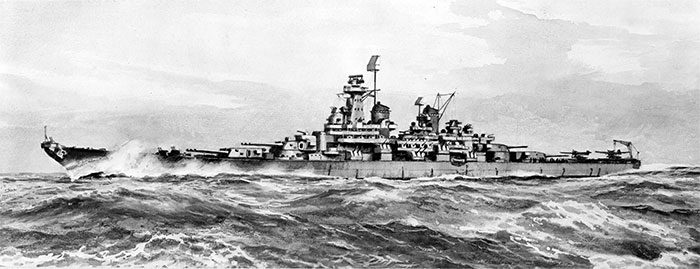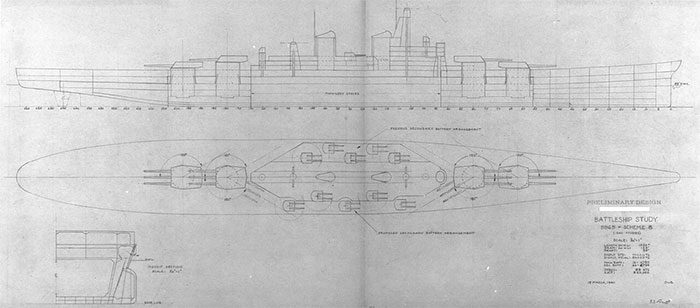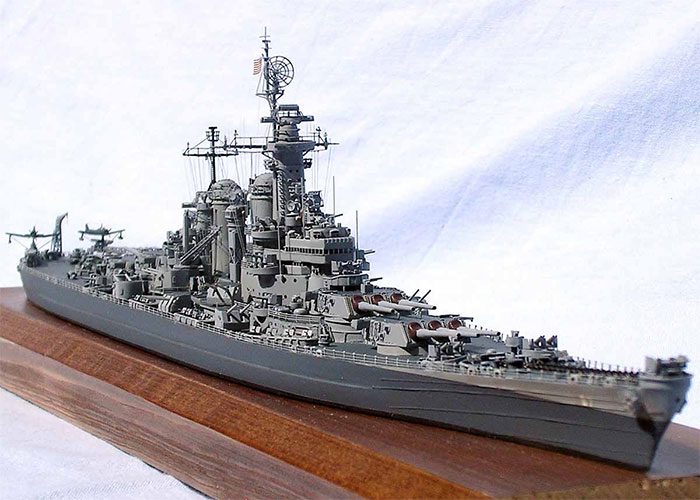During World War II, the United States battleship fleet became one of the strongest in the world thanks to the Iowa-class battleships. However, the Iowa was not the only battleship class considered for operation. Before the U.S. entered the war in 1939, Congress had approved plans for another battleship class, the Montana, which could be considered the largest in the U.S. arsenal. Unfortunately, the surprise attack by the Japanese in 1941 halted this project.
“Wiped Out” by the Attack on Pearl Harbor
When the attack on Pearl Harbor occurred on December 7, 1941, the absence of American aircraft carriers at the base spared them from destruction, allowing them to play a crucial role in the U.S. Navy’s counteroffensive in the Pacific. In fact, the aircraft carriers quickly rose in prominence, demonstrating their strategic value in naval warfare. As a result, today, aircraft carriers remain the backbone of global naval operations.
Meanwhile, this also marked the declining importance of battleships, to the extent that by the end of World War II, battleships were in their twilight. Therefore, the Montana-class battleships were never built, and all resources were redirected toward constructing more aircraft carriers. If the USS Montana had been constructed, it would have become the largest and most powerful battleship ever built by the United States, but the Japanese predetermined Montana’s fate with the attack on Pearl Harbor.

Illustration of the Montana-class battleship.
Five Montana-Class Battleships Were Approved
In July 1940, the U.S. Congress approved the construction of five Montana-class battleships. If built, the vessels would have been named USS Montana, USS Ohio, USS Maine, USS New Hampshire, and USS Louisiana. All five ships were to be constructed in Philadelphia, New York, and Virginia, but by 1943, all plans were canceled before any work had begun.
Had these five ships been built, the U.S. would have entered the war with 17 battleships, making it the largest fleet in the world. However, the U.S. was forced to change its strategy after losing four warships at Pearl Harbor, which accounted for 50% of the battleship fleet stationed there. The U.S. Navy adapted by focusing on aircraft carriers and air power, which proved to be more effective in the Pacific theater.

Design from 1940.
Design and Performance
The Montana was designed to be 280.8 meters long and 36.9 meters wide, with a height from the bottom to the waterline of 11 meters, while the USS Missouri measured 270.4 meters in length and 33 meters in width. Its standard and maximum displacement would have been 64,240 tons and 72,104 tons, respectively. The standard crew size was 2,355 personnel, but it could accommodate up to 2,789 people.
The propulsion system of the Montana included eight oil-fired boilers manufactured by Babcock & Wilcox, which would provide steam for four turbines, each driving one propeller. Each turbine was rated at 32 MW, giving a total propulsion power of 128 MW. This system would allow for a top speed of 52 km/h, while the cruising speed would be much slower at 28 km/h. The Montana was designed to carry 7,600 tons of fuel oil and had an operational range of 27,800 km.

Model of the Montana-class battleship.
Additionally, to meet projected electrical needs, Montana would have been equipped with 10 turbine generators rated at 1,250 kW, providing a total of 12,500 kW of electricity. In emergencies, the ship would also have been outfitted with two diesel generators rated at 500 kW. It can be said that Montana would have been like a brightly lit floating city at sea if it had been built.
The Montana-class battleships would have featured varying armor thicknesses across different parts of the ship. The hull would have boasted armor up to 409 mm thick, while the internal bulkheads would be 457 mm thick at the front and 387 mm at the rear. The deck armor was the thinnest, ranging from 179 to 187 mm. While increasing armor thickness would result in a heavier and slower ship, this was a trade-off to enhance the vessel’s defensive capabilities.
Weapon Systems
The primary armament of a Montana-class battleship would have consisted of twelve Mark 7 16-inch (406 mm)/50 caliber guns, mounted in four turrets, with three guns per turret. The turrets would have been arranged in pairs on the deck, with one pair at the front and one at the rear, with the command tower situated between them.

Secondary armament for Montana-class ships consisted of 20 Mark 16 multi-purpose guns, 5-inch (127 mm)/54 caliber.
On levels 3 and 4, each ship would have carried light anti-aircraft weapons consisting of 32 to 38 Bofors 40 mm guns and up to 56 Oerlikon 20 mm guns. The Bofors would be positioned on mounts scattered across the deck, while the Oerlikon guns would be installed individually. This dense array of weaponry would have provided 25% more firepower compared to Iowa-class battleships.
The Montana-class battleships were a dream that never came to fruition for the U.S. Navy. Had they been built, they would have represented the pinnacle of battleship design. However, World War II ended successfully without the involvement of these colossal ships, making the cancellation of the project a reasonable decision.


















































